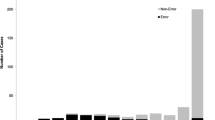ABSTRACT
BACKGROUND
Accurate patient problem lists are valuable tools for improving the quality of care, enabling clinical decision support, and facilitating research and quality measurement. However, problem lists are frequently inaccurate and out-of-date and use varies widely across providers.
OBJECTIVE
Our goal was to assess provider use of an electronic problem list and identify differences in usage between medical specialties.
DESIGN
Chart review of a random sample of 100,000 patients who had received care in the past two years at a Boston-based academic medical center.
PARTICIPANTS
Counts were collected of all notes and problems added for each patient from 1/1/2002 to 4/30/2010. For each entry, the recording provider and the clinic in which the entry was recorded was collected. We used the Healthcare Provider Taxonomy Code Set to categorize each clinic by specialty.
MAIN MEASURES
We analyzed the problem list use across specialties, controlling for note volume as a proxy for visits.
KEY RESULTS
A total of 2,264,051 notes and 158,105 problems were recorded in the electronic medical record for this population during the study period. Primary care providers added 82.3% of all problems, despite writing only 40.4% of all notes. Of all patients, 49.1% had an assigned primary care provider (PCP) affiliated with the hospital; patients with a PCP had an average of 4.7 documented problems compared to 1.5 problems for patients without a PCP.
CONCLUSIONS
Primary care providers were responsible for the majority of problem documentation; surgical and medical specialists and subspecialists recorded a disproportionately small number of problems on the problem list.

Similar content being viewed by others
REFERENCES
Hartung DM, Hunt J, Siemienczuk J, Miller H, Touchette DR. Clinical implications of an accurate problem list on heart failure treatment. J Gen Intern Med. 2005;20:143–7.
Wright A, Goldberg H, Hongsermeier T, Middleton B. A description and functional taxonomy of rule-based decision support content at a large integrated delivery network. J Am Med Inform Assoc. 2007;14:489–96.
Wright A, McGlinchey EA, Poon EG, Jenter CA, Bates DW, Simon SR. Ability to generate patient registries among practices with and without electronic health records. J Med Internet Res. 2009;11:e31.
Poon EG, Wright A, Simon SR, et al. Relationship between use of electronic health record features and health care quality: results of a statewide survey. Med Care. 2010;48:203–9.
Meaningful Use Workgroup Presentation to HIT Policy Committee. 2011. Available at: http://healthit.hhs.gov/portal/server.pt/gateway/PTARGS_0_12811_954838_0_0_18/hitpc-mu-recommendations-06-08-11.ppt. Accessed June 8, 2011.
Kaplan DM. Clear writing, clear thinking and the disappearing art of the problem list. J Hosp Med. 2007;2:199–202.
Szeto HC, Coleman RK, Gholami P, Hoffman BB, Goldstein MK. Accuracy of computerized outpatient diagnoses in a Veterans Affairs general medicine clinic. Am J Manage Care. 2002;8:37–43.
Tang PC, LaRosa MP, Gorden SM. Use of computer-based records, completeness of documentation, and appropriateness of documented clinical decisions. J Am Med Inform Assoc. 1999;6:245–51.
Feblowitz J, Wright A. The Patient Problem List: An Ethnographic Study of Primary Care Provider Use and Attitudes. AMIA 2011 Annual Symposium. Washington, D.C.; 2011 (under review).
Wright A, Maloney F, Feblowitz J. Clinician attitudes toward and use of electronic problem lists: a thematic analysis. BMC Med Inform Decis Mak. 2011;11:36–45.
Wright A, Pang J, Feblowitz J, et al. A method and knowledge base for automated inference of patient problems from structured data in an electronic medical record. J Am Med Inform Assoc. 2011;18:859–67.
Information Management Processes (Standard IM 6.40): 2008 Comprehensive Accreditation Manual for Hospitals: The Official Handbook. Oakbrook Terrace, Illinois: Joint Commission Resources: 2008.
McMullen CK, Ash JS, Sittig DF, et al. Rapid assessment of clinical information systems in the healthcare setting. An efficient method for time-pressed evaluation. Methods Inf Med. 2010;50:299–307.
Bonetti R, Castelli J, Childress JL, et al. Best practices for problem lists in an EHR. J AHIMA / Am Health Inf Manag Assoc. 2008;79:73–7.
ACKNOWLEDGEMENTS
This work was supported by a grant from the Partners Community HealthCare Incorporated (PCHI) System Improvement Grant Program and approved by the Partners HealthCare Institutional Review Board. PCHI was not involved in the design, execution or analysis of the study or in the preparation of this manuscript.
Prior Presentations
None to report.
Conflict of Interest
The authors declare that they do not have a conflict of interest.
Author information
Authors and Affiliations
Corresponding author
Rights and permissions
About this article
Cite this article
Wright, A., Feblowitz, J., Maloney, F.L. et al. Use of an Electronic Problem List by Primary Care Providers and Specialists. J GEN INTERN MED 27, 968–973 (2012). https://doi.org/10.1007/s11606-012-2033-5
Received:
Revised:
Accepted:
Published:
Issue Date:
DOI: https://doi.org/10.1007/s11606-012-2033-5




